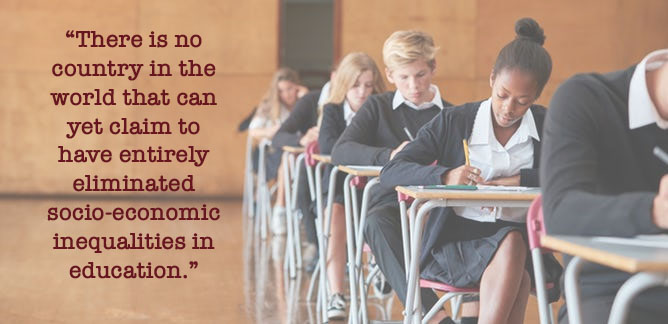A recently released report from the Organization for Economic Cooperation and Development (OECD) found that equity remains a challenge throughout the world. Overall, the report found, 15-year-olds from disadvantaged backgrounds scored 88 points lower in science on the 2015 Programme for International Student Assessment (PISA) than their more advantaged peers—the equivalent of three years of schooling. “There is no country in the world,” the report states, “that can yet claim to have entirely eliminated socio-economic inequalities in education.”

However, the report also shows that disadvantage is not destiny, and that there are countries that have succeeded in making socio-economic status less of a factor in educational outcomes and where disadvantaged students perform relatively well. And it suggests some policies to support disadvantaged students.
Across all countries that participated in the 2015 PISA, socio-economic status explained about 13 percent of the variation in results, the report found. (If the education systems were equitable, the amount of the variance explained by socio-economic status would be zero.) But some countries were closer to equity than others. Among high-performing countries, Canada, Estonia, Finland, Hong Kong, and Macao were relatively equitable; socio-economic status explained far less of the variance in results than the OECD average. In France, Hungary, Luxembourg, and Peru, by contrast, socio-economic status explained about 20 percent of the variance in results. In the United States, socio-economic status explained 11 percent of the variance in results.
Moreover, equity appears to have improved over time in most countries. The amount of the variance in science results explained by socio-economic status dropped from 14.4 percent in 2006 to 13 percent in 2015, and there were similar declines in reading and mathematics. In 11 countries, including the United States, equity in science performance improved between 2006 and 2015.
Another way of looking at equity, the proportion of “resilient” students—disadvantaged students who perform at high levels on PISA—also showed variations. In Chinese Taipei, Estonia, Finland, Hong Kong, Japan, Macao, and Singapore, more than 40 percent of disadvantaged students were “internationally resilient”; that is, they performed in the top quartile of all participating jurisdictions. In the United States, 31.6 percent of disadvantaged students were internationally resilient, just over the international average.
Hong Kong and Macao also led the world in the proportion of students who were “core-skills resilient”—those who performed at Level 3 or above (on a five-level scale) in reading, mathematics, and science. About half of disadvantaged students in Hong Kong and Macao were core-skills resilient, twice the international average, while in Estonia, Finland, Japan, and Singapore, about 40 percent of disadvantaged students were core-skills resilient. In the United States fewer than a fourth of students were core-skills resilient.
Yet even in some countries with relatively inequitable results, disadvantaged students still perform at high levels. For example, in Singapore, 9.5 percent of disadvantaged students are nationally resilient, meaning that disadvantaged students perform in the top quartile of the national results, fewer than the international average. But the lowest-performing students in Singapore—the bottom 10 percent—outperformed the bottom half of students in several industrialized countries, including Hungary, Iceland, Israel, and Luxembourg.
The OECD report suggests some policies that might improve educational equity. One is high-quality early childhood education (ECE). The report notes that achievement gaps between advantaged and disadvantaged students show up as early as age 10, based on results from the Trends in International Mathematics and Science Study (TIMSS). Therefore, the OECD report states, early intervention is critical. The report notes that studies from the United States have found that high-quality early-childhood education results in long-term benefits for disadvantaged children, yet in many countries, children from low-income and minority families are less likely than others to participate in these programs. The report recommends promoting greater access to early-childhood programs funding their development and improvements in quality.
To read more about how leading education systems are rapidly evolving their ECE systems, see CIEB’s new report, The Early Advantage.
The OECD report also recommends:
- Setting ambitious goals for equity and monitoring the progress of disadvantaged students;
- Developing teachers’ capacity to detect students and manage diverse classrooms;
- Targeting additional resources to disadvantaged children and schools;
- Reducing the concentration of disadvantaged children in particular schools;
- Fostering student well-being; and
- Encouraging parent-teacher communication and parental engagement.





